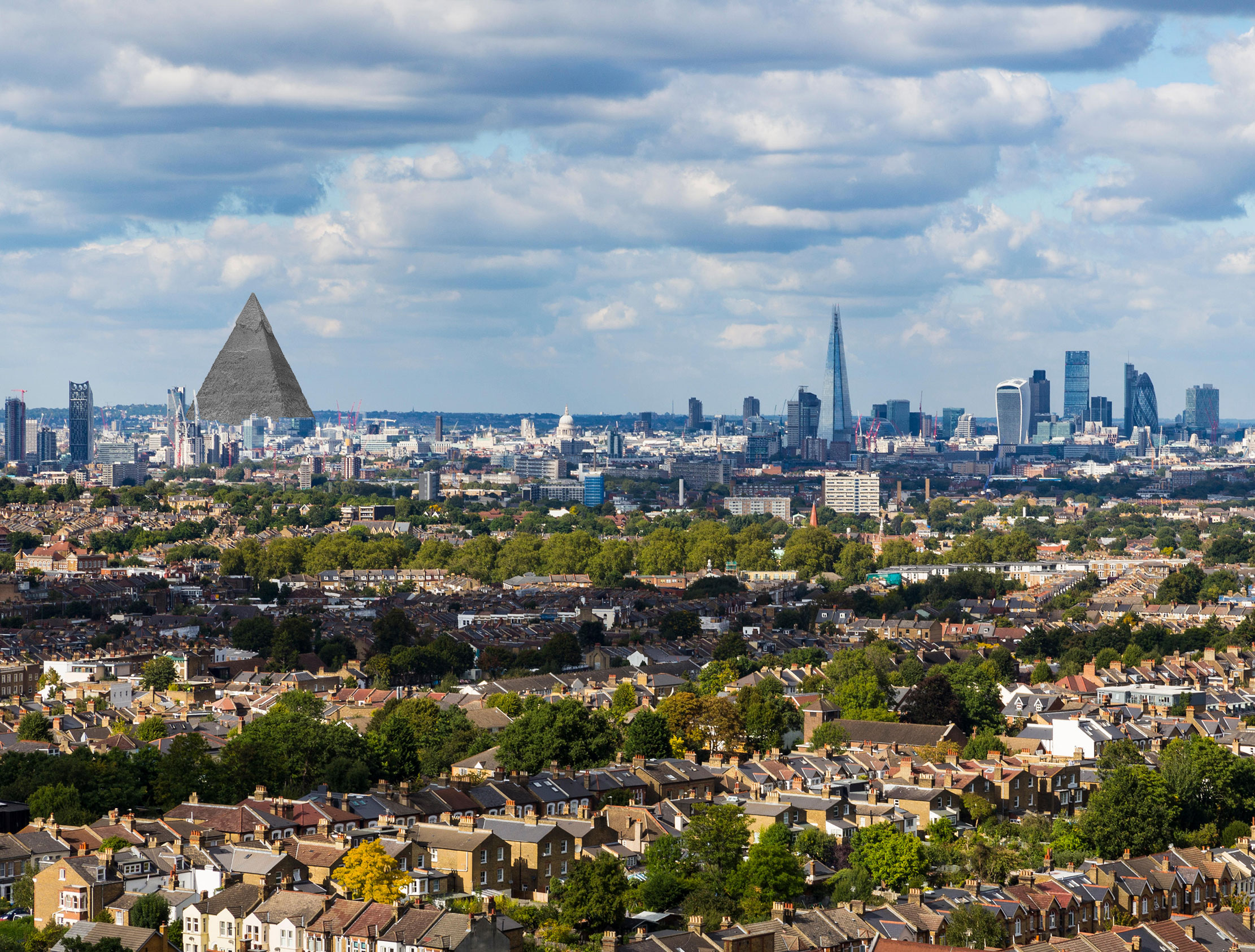The 'Death Pyramid' of Primrose Hill
Four times the height of St Paul's Cathedral, and with enough room for 5 million bodies, the Metropolitan Sepulchre was a fascinating curiosity that thankfully never left the drawing board.


Primrose Hill is a popular green space in north-west London. Gently ascending paths lead to a 210ft summit that offers extensive views across the crowded metropolis. Yet the immediate terrain would have looked different had plans to dig into the hill and erect a so-called ‘Death Pyramid’ been realised in the early 19th century.
The base of the necropolis, officially to be named the Metropolitan Sepulchre, was intended to occupy an area equivalent to three times the size of Bloomsbury’s Russell Square, one of London’s largest garden squares. With a volume exceeding that of the Great Pyramid of Giza, its 94 storeys would have risen to four times the height of St Paul’s Cathedral (365ft), according to The Literary Gazette.
What the Gazette dismissed as ‘a monstrous piece of folly’ had been conceived in response to the growing scandal of London’s overcrowded graveyards. These had long presented a public health hazard. More than a century before, Sir Christopher Wren suggested ending the practice of burials in churches and churchyards and creating cemeteries on the more salubrious edges of town.
The idea had been rejected by the Corporation of London, but as the capital’s population continued to expand, so did the issue of the dignified burial and secure interment of the dead. The opening of the Père-Lachaise Cemetery, with an appearance more akin to a landscaped park than a conventional graveyard, in Paris’s 20th arrondissement in 1804, inspired renewed efforts to address the problem.
The first scheme for a cemetery at Primrose Hill came from George Frederick Carden, a barrister with a close interest in burial reform. His proposal, first outlined in 1824, was for a garden cemetery tastefully laid out on the lines of Père-Lachaise. Church architect Francis Goodwin (subsequently the first to propose the creation of a cemetery at Highgate) offered a more grandiose proposal, to be sited either at Primrose Hill, or near Shooter’s Hill, south London, adorned with facsimiles of the most famous temples and monuments of classical Athens and Rome. But it was Thomas Willson, towards the end of the 1820s, who came up with the outlandish idea of a brick pyramid, faced with blocks of granite, which would be the last resting place of more than five million Londoners, at the rate of 40,000 burials per year.
'Wilson claimed it would be "an impressive memento mori to every passing age" and a "coup d’oeil of sepulchral magnificence unequalled in the world"'
Willson, a minor architect whose ideas for a mausoleum to Lord Nelson and a National Mausoleum for Naval and Military Heroes had already gone unfulfilled, claimed it would be ‘an impressive memento mori to every passing age’ and a ‘coup d’oeil of sepulchral magnificence unequalled in the world’.
Four large portals on each side of the structure would lead mourners to a main avenue with a huge ventilation shaft at its centre. Instead of stairways, sloping ramps would facilitate the moving of coffins through the levels. There were to be more than 200,000 catacombs, each with space for 24 coffins, to be sealed for eternity on reaching that number. ‘Whether inside or out, the pyramid would beguile the hours of the curious and impress feelings of solemn awe and admiration upon every beholder,’ wrote Willson.
Exquisite houses, the beauty of Nature, and how to get the most from your life, straight to your inbox.
Yet it never happened. A commercial cemetery represented radical thinking for the time, but, in 1829, Willson announced he’d be asking Parliament for a charter enabling him to press ahead with the initiative. However, there were concerns about the safety of the structure and its immense weight causing the collapse of the hill.
In any case, a year later Carden relaunched his more sober plan for a ‘British Père-Lachaise’, financed via his General Cemetery Company. Carden enlisted the support of Willson, who withdrew his pyramid proposal, enabling a full concentration of resources on getting Carden’s scheme through. In 1832 an act ‘establishing a general Cemetery for the internment of the Dead in the neighbourhood of the Metropolis’ received royal assent. Carden’s company purchased 54 acres of land enabling Kensal Green in 1833 to become the first of London’s ‘magnificent seven’ garden cemeteries (followed by West Norwood, Highgate, Nunhead, Abney Park, Brompton and Tower Hamlets).
Thus, Primrose Hill was spared. Londoners were never to be treated to the spectacle of a pyramid, although the issue of burials remained a thorny one. In 1860, in his All the Year Round magazine, notwithstanding the big new cemeteries, Charles Dickens was still noting that London smelt ‘of rot and mildew and dead citizens’.
For all its romantic appeal, however, Willson’s vision would have surely been an oppressive feature, casting long, dark shadows over Primrose Hill and Camden’s growing lines of terraces. A fascinating curiosity, it’s probably as well it never left the drawing board.
Jack Watkins is a freelance writer and long-time contributor to Country Life

Credit: Country Life / Whitehouse.gov
Donald Trump's new home: 100 years of change at The White House
In December 1916 Country Life magazine was granted extraordinary access to The White House.
Jack Watkins has written on conservation and Nature for The Independent, The Guardian and The Daily Telegraph. He also writes about lost London, history, ghosts — and on early rock 'n' roll, soul and the neglected art of crooning for various music magazines
